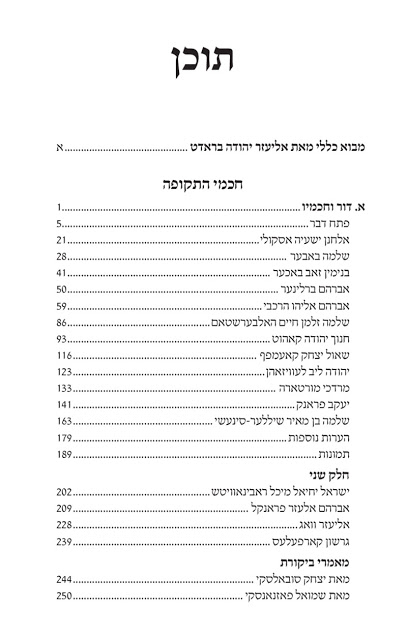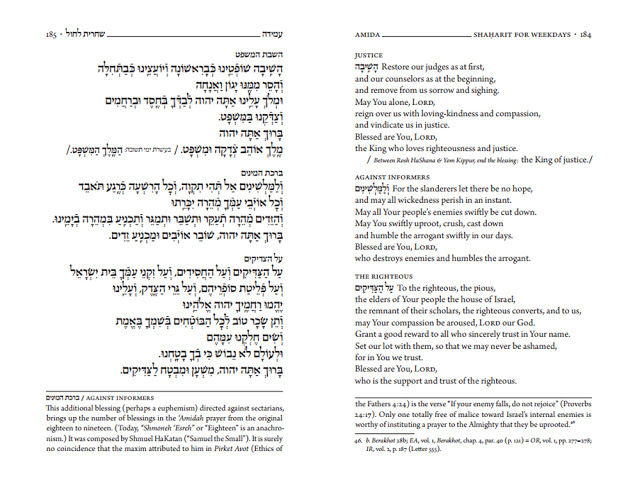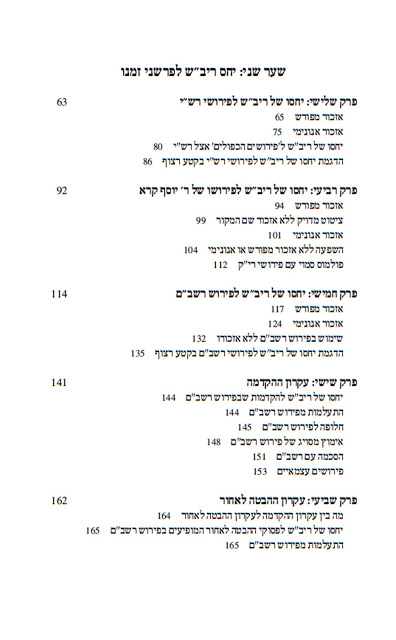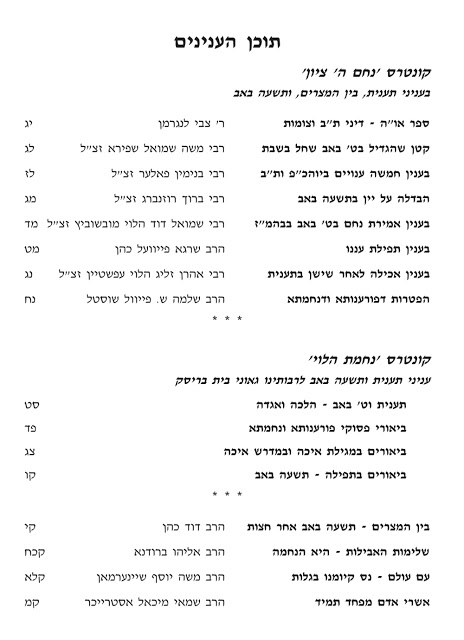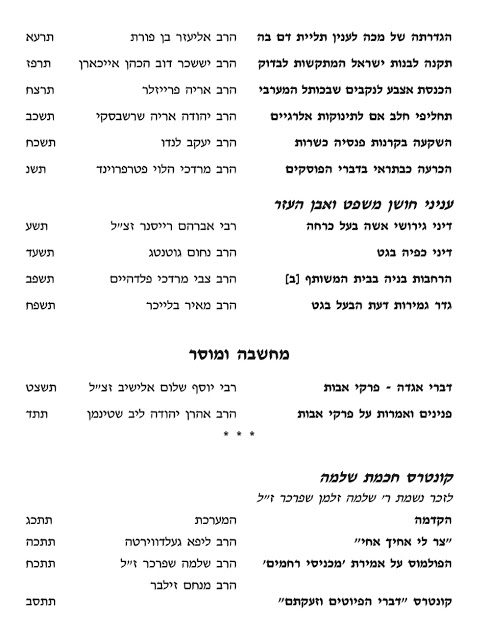Book week & The International Book Fair 2017 Updated
By Eliezer Brodt
Book week just began in Eretz Yisrael. As I have written the
past ten years, every year in Israel, around Shavous time, there is a period of
about ten days called
Shavuah Hasefer – Book Week (for previous years
lists see
here,
here,
here,
here,
here,
here,
here,
here,
here and
here). Many of the companies offer sales for the whole month.
Shavuah
HaSefer is a sale which takes place all across the country in stores, malls
and special places rented out just for the sales. There are places where
strictly “frum” seforim are sold and other places have most of the secular
publishing houses.
Many publishing houses release new titles specifically at
this time, some books are released during the week (thus the Update). Not all
of the books listed below can be found at the various fairs as some companies
do not come to the fairs and only offer sales via the Web.
Some of the sales end this week others other expire only at
the end of the month.
Some of the frum companies began their sale last week [such
as Ahavat Sholom] others like Mechon Yerushlayim and Zichron Aron begin their
sales this coming Sunday [PDF of Catalogs available upon request.]
This year International Book week is taking place right next
to the Book fair in Jerusalem. For the Most part, the booths worth visiting are
from Urim, Gefen, Pomerantz (Kodesh books), and Maggid (they have booths at
both fairs). [See below for some recommendations].
In my lists, I sometimes include an older title, from
a previous year, if I just noticed the book. As I have written in the past, I
do not intend to include all the new books. Eventually some of these titles
will be the subject of their own reviews. I try to include titles of broad
interest. As this list shows although book publishing in book form has dropped
greatly worldwide, (and continues to drop) Academic books on Jewish related
topics are still coming out in full force.
As in previous years I am offering a service, for a small
fee to help one purchase these titles (or titles of previous years). For
more information about this email me at Eliezerbrodt-at-gmail.com. Part of
the proceeds will be going to support the efforts of the the Seforim Blog.
בן צבי
1.
שלמה דב גויטיין,
התימנים: היסטוריה, סדרי חברה, חיי רוח, מבחר מחקרים [הדפסה שניה], מכון בן צבי,
374 עמודים
2.
עפר אליאור, רוח
חן, יחלוף על פניי, יהודים, מדע וקריאה 1210-1986, בן צבי, 360 עמודים
3.
בית דינו של
שמואל, תשובות רבי שמואל לאנייאדו וחכמי דורו, ההדירה: לאה בורנשטיין-מקובצקי, בן
צבי, ב’ חלקים
4.
גנזי קדם יב
5.
מרדכי עקיבא
פרידמן, מילון הערבית היהודית מימי הביניים, 1017 עמודים
6.
מוטי בנמלך, שלמה
מולכו, חייו ומותו של משיח בן יוסף, 438 עמודים
7.
נעמה וילוז’ני,
שערות לילות וקרני אשמדאי, דמות וצורה במאגיה ובאמנות העממית בין בבל לארץ ישראל
בשלהי העת העתיקה, 444 עמודים
8.
צפי זבה אלרן,
זיכרונת חדשים אסופות האגדה ועיצובו של קנון עברי מודרני, 318 עמודים
9.
קיימי קפלן, עמרם
בלוי – עולמו של מנהיג נטורי קרתא, 593 עמודים
10.
יהושע בלאו,
סימון הופקינס, הערבית-היהודית הקדומה בכתיב פונטי, חלק א, טקסטים מקראיים משלהי
האלף הראשון, 586 עמודים
מאנגס
1.
ברית המנוחה, ההדיר:
עודד פורת, מהדורה מדעית ומבואות, ספריית הילל בן חיים, מגנס, 610 עמודים
2.
אריאל פורסטנברג,
שפת השיח התלמודי, עיון פילוסופי בדרכי ההתהוות של ההלכה האמוראית, מגנס, 262
עמודים
3.
שלום צדיק, מהות
הבחירה בהגות היהודית בימי הביניים, מגנס, 348 עמודים
4.
אהרן שמש, עונשים
וחטאים מן המקרא לספרות חז”ל, הדפסה שנייה, מגנס, 250 עמודים
5.
יובל בלנקובסקי,
חטא לשם שמים, עבריה לשמה בעולמם של חכמים, מגנס, 224 עמודים
6.
דב שוורץ, רחק
וקרוב הגות יהודית בביזנטיון בשלהי ימי הביניים, מגנס, 540 עמודים
7.
יצחק ברנד, יש
מאין, עסקאות בנכסים מופשטים במשפט התלמודי, 484 עמודים
9.
אדם
לאדם, מחקרים בפילוסופיה יהודית בימי הביניים ובעת החדשה מוגשים לפרופ’ זאב הרוי
על ידי תלמידיו במלאות לו שבעים, 726 עמודים
10.
יחזקאל, ב’
חלקים, מקרא לישראל
11.
אילן אלדר,
הבלשנות העברית בימי הביניים, 426 עמודים
12.
דוד צרי, חוץ
מיראת שמים, בידי שמים ובידי אדם בדרושי ראשית החסידות, 395 עמודים
13.
משה פלאי, כוכבי
יצחק, כתב העת של ההשכלה באימפריה האוסטרו הונגרית, 629 עמודים
14.
נפש האדם, פירוש
קהלת לר’ שמואל בן יהודה אבן תיבון, מהדיר יעקב רובינסון, איגוד, 610 עמודים
15. דרשות
משנות הזעם, ב’ חלקים [אש קודש], ההדיר: דניאל רייזר
ביאליק
2.
אברהם גרוסמן,
תמורות בחברה היהודית בימי הביניים, 559 עמודים
3.
ירון צור, גבירים
ויהודים אחרים במזרח התיכון העות’מאני 1750-1830
4.
יעקב בלידשטיין,
‘ובהם נהגה’ – עיונים בהלכות תלמוד תורה לרמב”ם
5.
התפילה בישראל:
היבטים חדשים, בעריכת אורי ארליך
6.
מדרשי גאולה,
בעריכת יהודה אבן שמואל, עם מבוא מאת עודד עיר שי
כרמל
1.
עמנואל אטקס, לשם
שמים: חסידים, מתנגדים, משכילים ומה שביניהם, 466 עמודים
מגיד-אופק
1.
חיים סולוביצ’יק,
יינם, סחר ביינם של גויים על גלגולה של הלכה בעולם המעשה, 232 עמודים [מהדורה שניה
עם הוספות]
2.
תוספות ר”י
הזקן ותלמידיו, ג, אופק
3.
חידושין על התורה
לרבינו תם ובית מדרשו, אופק, 121+תקפט עמודים
4.
Rabbi
J. D. Bleich, Contemporary Halakhic Problems, Volume VII, 524 pp.
5.
Rabbi
Joseph B. Soloveitchik, Halakhic Morality, Essays on Ethics and Masorah,
237 pp.
6.
Rabbi
Aron Lichtenstein, By his Light Character and Value in the service of God,
252 pp.
7.
Rabbi
Daniel Z. Feldman, False Facts and True Rumors, Lashon Hara In Contemporary
Culture,333 pp.
כנרת-דביר
1.
ספר האגדה
2.
יעקב נגן, נשמת
המשנה, קריאה ספרותית וחיפוש משמעות, דביר, 462 עמודים
3.
דוד
רוטמן, דרקונים, שדים ומחוזות קסומים, על
המפולא בסיפור העברי בימי הביניים, 575 עמודים
4.
שלו’ ירושלמי,
יוסי אליטוב ואריה אלריך, ברגע האמת, הרבי מלובביץ’ והדיאלוג הביטחוני מדיני עם
מקבלי החלטות בישראל, 476 עמודים
5.
יונתן
סרנה,
לינקולן והיהודים, 288 עמודים
מכון שכטר – JTS
1.
חברה יהודית
ים-תיכונית בשלהי ימי הביניים לאור גניזת קהיר, אברהם דוד
2.
מדרש קהלת רבה א- ו, בעריכת מנחם הירשמן, קנ+363 עמודים
ספריית הילל בן
חיים
1.
יהודי ביטי,
הפילוסוף המקובל, עיונים בספר קול הנבואה, ספריית הילל בן חיים, 300 עמודים
2.
יהודית וייס,
משיח נוצרי קבלי ברנסנס, גיום פוסטל וספר הזוהר, ספריית הילל בן חיים, 355 עמודים
3.
יוסף שטרן, החומר
וצורה במורה נבוכים לרמב”ם
4.
ורד טוהר, חיבור
המעשיות והמדרשות וההגדות (פירארה שי”ד)
מרכז זלמן שזר
1.
בין בבל לארץ
ישראל, שי לישעיהו גפני, שזר, 500 עמודים
2.
סדריק כהן סקליל,
דון יצחק אברבנאל, שזר, 286 עמודים
3.
רוני באר-מרקס, על חומת הנייר: עיתון הלבנון והאורתודוקסיה, 350 עמודים
4.
תמונת עבר, שי לירחמיאל כהן, בעריכת עזרא מנדלסון, 423 עמודים
5.
חב”ד היסטוריה, הגות ודימוי, בעריכת גדי שגיב יונתן מאיר
6.
שמואל פיינר, עת חדשה יהודים באירופה במאה השמונה עשרה, 583
עמודים
7.
אהרן אופנהיימר, על נהרות בבל: סוגית בתולדות בבל התלמודית
8.
אורית רמון, מהר”ל באור חדש, זהות יהודית בסדר עולם
משתנה, 288 עמודים
9.
סנג’יי
סוברהמניים, שלוש דרכים להיות זר
10. דברה
קפלן, שטרסבורג, יהודים נוצרים רפורמציה
מכללת הרצוג
1.
נטועים כ [חומר
חשוב], 283 עמודים
2.
יונתן גרוסמן,
מגילת רות גשרים וגבולות, הרצוג, 414 עמודים
3.
דב שוורץ, דילוג
אל האור [מושגי יסוד בהגהות חב”ד], 353 עמודים
4.
ר’ דוד פוקס,
לנטוע שמים
ראובן מס
1.
רחל רייך, מעשה
פילגש בגבעה, ניתוח ספרותי, ראובן מס, 200 עמודים
2.
משה בר אשר,
לשוננו רנה, עיוני תפילות בלשון ובסגנון בתכנים בנוסחות ובמנהגים, 382 עמודים
3.
ישראל נתנאל
רובין, מה שאלוקים לא יכול,
בר אילן
1.
אריאל רוט, כיצד
לקרוא את ספרות חב”ד, 300 עמודים
2.
דרכי דניאל,
מחקרים במדעי היהדות לכבוד הרב פרופסור דניאל שפרבר, בעריכת אדם פרזיגר, 992
עמודים
3.
איתי מרינברג-מיליקובסקי,
לא ידענו מה היה לו: ספרות ומשמעות באגדה התלמודית, 236 עמודים
4.
בד”ד 31
5.
סידרא לא
6.
דעת 82
7.
דעת 83
8.
צבי שטיינפלד,
הוריות, מחקרים במשנה ובתלמודים, 572
עמודים
9.
פירוש קדמון על
מורה נבוכים, 556 עמודים
10.
אוריאל סימון,
אזן מלין תבחן [מהדורה שניה], מחקרים בדרכו הפרשנית של ר’ אברהם אבן עזרא, 568 עמודים
11.
צבי קדרי, מילון
העברית המקראית [הדפסה שלישית]
12.
A Dictionary of
Jewish Palestinian Aramaic of the Byzantine Period [מהדורה שלישית]
13. אברהם
אופיר שמש, ריח גן עדן, ריחות בשמים וקטורת במסורת היהודית,348 עמודים
ידיעות ספרים
1.
ר’ יצחק אייזיק
הלוי הרצוג, המוסדות העיקרים של המשפט העברי, ב’ חלקים,
2.
נמרוד זינגר, בעל
שם והרופא, רפואה ומאגיה בקרב יהודי בראשת העת החדשה
3.
ר’ לוי יצחק
מברדיצ’ב, בעריכת צבי מרק
4.
יואל בן נון
ושאול ברוכי, מקראות עיון רב תחומי בתורה, יתרו, 278 עמודים
רסלינג
1.
נעמי פריש, אתרוג
הלב מסה על ארבעת המינים, 257 עמודים
2.
יעקב אזואלוס,
תורת המלאכים בתרגומים הארמיים לתורה, 222 עמודים
3.
מורן הכהן, מחקר
הקבלה בישראל, היסטוריוגרפיה אידיאלוגיה ומאבק על הון תרבותי, 315 עמודים
אוניברסיטת תל אביב:
1.
אופיר מינץ־מנור,
הפיוט הקדום,
2.
תומר פרסיקו מדיטציה
יהודית: התפתחותן של תרגולות רוחניות ביהדות זמננו,
3.
מור אלטשולר, חיי מרן יוסף קארו
4.
שניצר מימון, אונס בין הלכה למציאות- היחס לכפיית מין על נשים
בקהילות יהודי גרמניה בימי הביניים
האקדמיה ללשון העברית
1.
תלמוד ירושלמי, קונטרס תיקונים מורחב
2.
תלמוד ירושלמי, מפעל המילון ההיסטורי, הדפסת שלישית עם קו’
תיקונים מורחב
3.
ענייני התחביר שבכתאב אלתנקיח (ספר הדקדוק) לר’ יונה אבן
ג’נאח, דוד טנא
4.
שמעון שרביט,
תורת ההגה של לשון חכמים
5.
אילן אלדר,
לתולדת תורת הלשון העברית בימי הביניים
האסכולה האנדלוסית, 208 עמודים
בית אל
1.
הילה וולברשטין,
איש כי יפליא, על ר’ דוד הנזיר,
2.
ד”ר חנה
קהת, ביחד, מדריך לבניית אינטימיות זוגית בריאה, 128 עמודים
3.
תחומין, כרך לז
4.
נעם ארנון,
המערה, תגליות ומחקרים במערת המכפלה
כתר
1.
משה אידל,
שלשלאות קסומות, טכניקות וריטואלים במיסטיקה היהודית, 277 עמודים
הוצאת אדרא
1.
יהודה ליבס, לצבי
ולגאון, משבתי צבי אל גאון מווילנא, 408 עמודים
2.
משה חלמיש,
הריטואל הקבלי- שילוב של הגות ומעש
The following titles
were at the International Book Fair:
Gefen Books
1.
Georges
Weisz, Theodor Herzel: A New Reading, 295 pp.
2.
Albert
Londres, The Wandering Jew Has arrived, 203 pp.
3.
Shaul
Meizlish,The Rabbinate in Stormy Days, The Life and Teachings of Rabbi Yitzhak
Isaac HaLevi Herzog, The First Chief Rabbi of Israel
Urim
1.
Maimonides Between Philosophy and Halakhah, Rabbi Joseph
Soloveitchik’s Lectures on the Guide of the Perplexed, Edited with and
Introduction by Lawrence Kaplan, 256 pp.
2.
Yitzchak
Etshalom,
Between the lines of the Bible: Exodus: 220 pp. (reviewed
here)
3.
Yitzchak
Etshalom, Between the lines of the Bible: Genesis, 268 pp. Revised and
Expanded
4.
Moshe
Sokolow, Tanakh, And Owners Manual :Authorship Canonization, Masoretic
Text, Exegesis, Modern Scholarship and Pedagogy, 219 pp. [Excellent]
5.
Rabbi
Michael Broyde, A Concise Code of Jewish Law for Converts, 180 pp.
Pomerantz
-Kodesh Books
1.
Mitchell
First, Esther Unmasked, Solving Eleven Mysteries of the Jewish Holidays and
Liturgy, 241 pp., Kodesh Press
2.
When God Becomes History: Historical
Essays of R’ Kook Edited by Bezalel Naor,263 pp.
3.
Rabbi
Haim Sabato, Seeking His Presence, Conversations with Rabbi Aharon
Lichtenstein, 368 pp. [Excellent]
